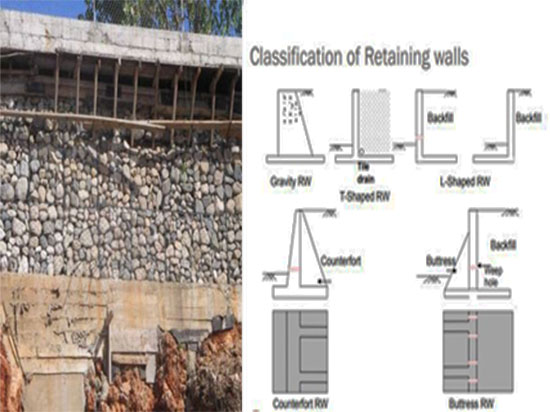Forces Acting on a Retaining Wall
- Concrete Cost Estimator
- Concrete Continuous Footing
- Landscape Bidding and Estimating
- Construction Cost Estimating
- Concrete and steel cost estimation
- Construction Cost Estimate Breakdown
- Construction Estimating Worksheet
- Home Construction Cost Estimate
- Estimate Pricing Sheet
- Sheet for General Contractor
- Construction Cost Estimate
- Labor Materials Cost Estimator
- Masonry Estimating Sheet
- Sheet for Building Contractor
- Construction Schedule Bar chart
- General Cost Estimator Sheet
- General Construction Estimate
- Building and Road Estimating Sheet
- Detailed expense estimates
- Door and Window Takeoff Sheet
- General Construction Cost Estimating Sheet

Retaining Wall Design
A retaining wall means a wall that is designed to maintain a level difference of the soil on its both sides. Normally, the retaining wall construction is done to restrain soil mass. Besides, it is erected for artistic landscaping purposes.
The supporting constituents are taken as either immovable or flexible. The rigid types are primarily constructed with masonry, simple concrete or reinforced concrete. The flexible types are defined as sheet pile walls. They are normally constructed with steel.
Based on the primary function to retain the soil mass, the retaining wall types range from gravity, cantilever, and counterfort.
Types Forces Enforcing On Retaining Wall
The following types of forces are found on retaining wall :-
1. Weight of the wall
This force remains active on the gravity centroid of the section.
2. Pressure of the retained soil
3. The pressures on the foundation.
They are linearly allocated in the form of a trapezoidal diagram.
4. The pressure of the soil against the front of the wall
The soil on the front of the wall applies a passive force (resistance) against the active force of the retained soil. Generally, this force is not taken into consideration because of the uncertainty of its magnitude.
Also Read: How to design cantilever retaining wall and its all parts
5. The loads on the retained soil
6. Forces caused by water
With the existence of a body of water on the back of the wall, a hydrostatic pressure remains active on it. To avoid the pressure sufficient drainage should be installed.
7. Sub Pressures
When the drainage under the wall is insufficient or is damaged, the water can be accumulated in that zone. If the foundation is impermeable, the water will stream unless it will appear on the frontal part of the soil. If the foundation is penetrable, the water produces pressure against the wall.
8. Vibration
They are created with traffic, power plants, and others. Usually, vibrations effects are not taken into consideration. In some cases, engineers just apply the magnitude in place of the normal component of the pressures of the retained soil on the wall to overdesign the wall to get rid of the issues caused by vibrations.
9. Effect of forces on the retained soil
The effects are weaken by the soil, consequently they are omitted.
10. Stresses Owing to frozen water
If the drainage is insufficient, it will create expansions of the retained soil when the water is frost.
11. Expansions because of changes of humidity on the retained soil
On clay soils the expansions lead to rise of the pressures produced by the retained soil on the wall. When the soil is dried, it contracts and the pressures are reduced for that reason. If it is continued, it can damage the wall. It is mainly found on the surface, and then it is reduced with depth.
It is difficult to measure the increases of pressure because of the humidity. However, they are avoided with the inclusion of coarse-grained soils stratums.
Categorization Of Retaining Wall
- Gravity wall-masonry or plain concrete
- Cantilever retaining wall - RCC (Inverted T and L)
- Counterfort retaining wall - RCC
- Buttress wall-RCC
Earth Pressure (P)
Earth pressure is formed by the retaining material on the retaining wall. This pressure is like to deflect the exterior wall.
Types of earth pressure :
- Active earth pressure or earth pressure (Pa)
- Passive earth pressure (Pp)
- Active earth pressure is likely to deflect the wall away from the backfill
Factors affecting earth pressure
Earth pressure is impacted by the type of backfill, the height of wall and the soil conditions.
Soil conditions: The following types of soil conditions are found
- Dry leveled back fill
- Moist leveled backfill
- Submerged leveled backfill
- Leveled backfill with uniform surcharge
- Backfill with sloping surface
Stability requirements of RW
Following conditions should be fulfilled for stability of wall (IS:456-2000).
- It should not overturn
- It should not slide
- It should not subside, i.e Max. pressure at the toe should not surpass the safe bearing strength of the soil under working condition
- Application of concrete calculator
- Roofing Calculator can streamline the roof estimating process
- House construction cost calculator
- Engineering column design excel spreadsheet
- Material Estimating Sheet with Excel
- Materials List and Cost Estimate Worksheet
- Concrete Slab Estimating Calculator Sheet
- Common types of foundations for buildings
- Online calculation of construction materials
- Estimating with Excel for the Small Contractor
- Concrete Beam Design Spreadsheet
- Virtual Construction Management app for construction
- Autodesk’s Project Skyscraper
- Reed Construction’s Reed Insight
- Manage your construction project documentation
- Costimator, the popular cost estimating software
- On Center Software for construction professionals
- Free Construction Estimating Software
- Plumbing Calc Pro
- Cost Estimate Worksheet
- HVAC Piping Quantity Takeoff Worksheet
- Construction Estimating Software Sheet
- Estimate Cost Templates
- Construction Punch List
- Construction cost estimating template consisting estimating basic
- Gantt Chart Template for Excel
- Download Civil Engineering Spreadsheets with Verification
- The Building Advisor Estimating and Budgeting Worksheet
- Spreadsheet for design of concrete bridge
- Construction Estimating Software Free









